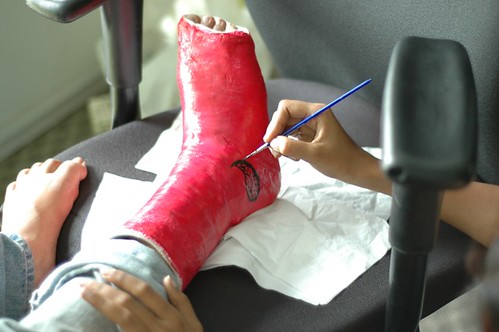Treatment for Torn Ligaments
Published by Nanni on Friday, August 17, 2012
Photo credit by herr_josh
A torn ligament most often occurs when you overstretch or twist your joint. Both the knees and ankles are most vulnerable to this type of injury.
Typically when you suffer from an injury to a ligament, you will hear a cracking or snapping sound which is subsequently followed by swelling, bruising as well as pain when you bear down on the joint. Also, you will be limited with regards to your range of motion. Usually a dent will appear in the spot where the ligament was torn.
For preventing a ligament injury, it’s recommended that you use an elastic bandage, especially if you’ve experienced a number of tears. Also, it’s best to refrain from sports that necessitate the use of quick or intense movements such as sprinting, racketball, tennis or squash.
To better understand the treatment involved for ligament tears, it’s helpful to know something about the ligament itself. Ligaments, definitively, are elastic, white fibrous tissues which are part of the skeletal joints. The purpose of the ligament is to cover and protect the bones so you can move more easily. Ligament sites include the knee, ankle, liver and uterus. However, injury is common in the areas of the knee and ankle.
People often suffer from ligament damage because they exert a great deal of pressure and weight on the area where the ligment is torn. Once a ligament is torn, an individual will not have the same degree of strength or mobility he once had before the injury. Therefore, as a result, the sufferer often experiences repeated tears and inflammation.
To treat a ligament at home, make sure then that you keep the injured area elevated and place ice on it. Apply compression dressings such as splints and bandages. It typically takes about two to three months for recovery. Because a ligament is a connective tissue with a low supply of blood, it takes a great deal longer for you to heal when you receive such an injury.
If the joint has been severely damaged, then it will be necessary to see a doctor and determine if an operation may be required. To return a ligament to its former condition, it may take a number of surgeries for the ligament to become stronger. Part of this process includes physical therapy which is an important component with respect to recuperation. Therefore, if your ligament has been torn, it’s important, as stated, to avoid any intense movement. Jumping and running are strictly forbidden, particularly if you’ve torn a ligament in the knee or ankle area.
A torn meniscus (fractured ankle) or torn ligament in the knee can sideline any further athletic activities especially if you let the injury go unattended. Therefore, early intervention is important when a mishap occurs.
Thus, for an incomplete tear, a physician may suggest that you start an exercise regimen to strengthen the area surrounding the injury. A brace may also be prescribed if your injury involves the knee. Usually an MRI is indicated in order to determine if the ligament is torn completely.
Tears to the knee ligament which happen to the inside of the knee are referred to as medial collateral ligament (MCL) injuries. If they occur on the outside of the knee, they are referred to as lateral collateral ligament (LCL) injuries. MCL injuries happen more often than LCL injuries, and occur frequently in such sports as football and hockey.
If a ligament has been badly torn, it may be followed by tear to the anterior cruciate ligament (ACL) which connects the upper leg bone with the lower leg bone. If you experience this kind of tear, your knee will feel unstable when you walk. When this type of tear occurs, surgery is often recommended.
Whether you experience a tear in the knee or the ankle, the initial prescription is to follow the acronym of RICE or Rest, Ice, Compression and Elevation. Therefore, it’s suggested that you rest the injured area by elevating it and apply ice and a compression bandage in order to relieve the pain and swelling in order to promote healing. Doing so can keep you from having to resort to a more extreme type of therapy such as surgery.
 | Posted in »
| Posted in »

0 comments: Responses to “ Treatment for Torn Ligaments ”